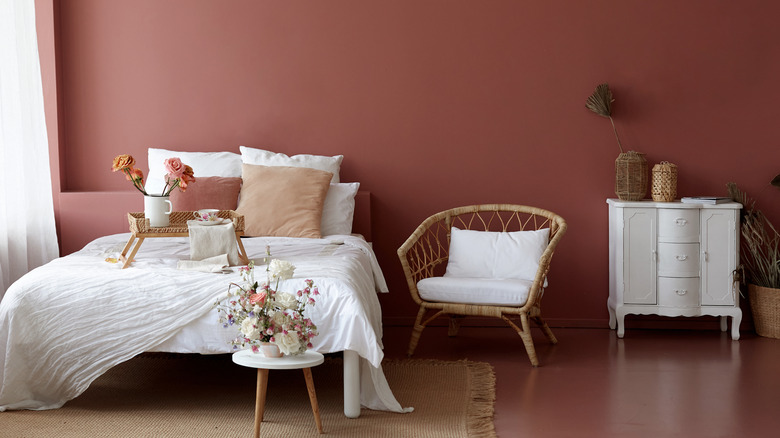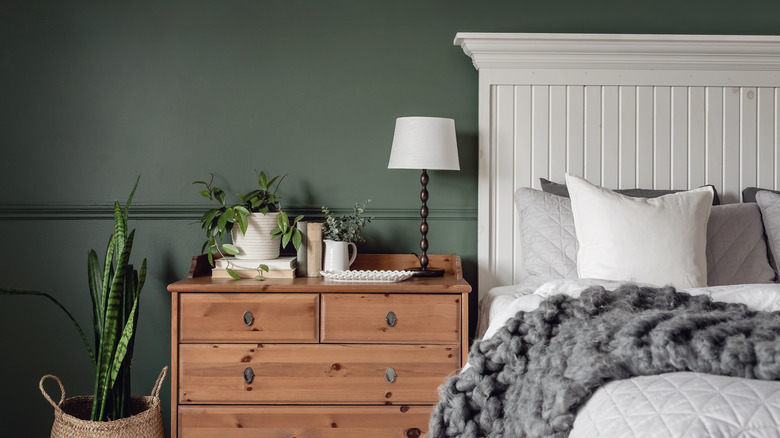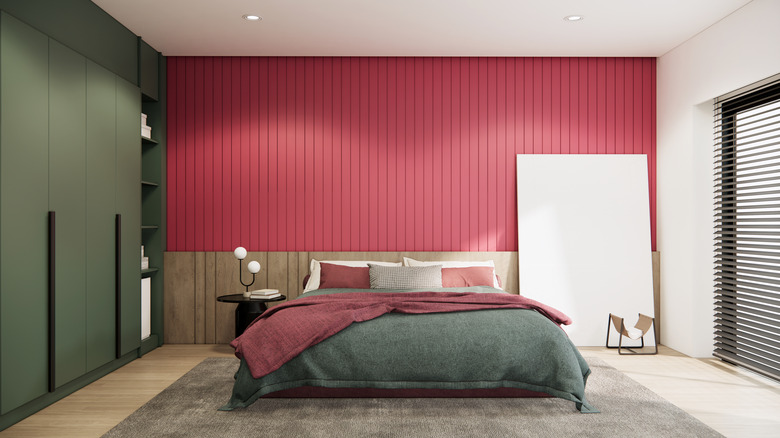The 10 Best Wall Colors For A Bedroom And 5 To Avoid, According To Color Theory
We may receive a commission on purchases made from links.
Color is complicated, with symbolic meaning and psychological impacts many of us may not be aware of. According to color experts, colors used in room decor, especially wall colors, can affect our moods and even our health. The best colors for certain rooms are often linked to a room's function. In the bedroom, paint colors that help create a peaceful environment are recommended. This article explores which shades are suitable for bedrooms, and which ones are best avoided.
When I taught film studies, I designed and taught a course on the symbolic use of color in cinema. Technicolor was a major innovation that allowed color to tell the story. Those ruby slippers in "The Wizard of Oz," for example, represent emotion and feminine power. Dorothy's blue gingham pinafore? Innocence and integrity. The Emerald City? Wealth and abundance. But color symbolism is also affected by context, and different shades and hues have different meanings. Some shades of green, for example, bring about a sense of harmony, nature, or healing, while others might symbolize illness or decay.
There are paint colors that are versatile enough to work in any room, while some colors seem to be less flexible. A sunny yellow kitchen is inviting and cheerful, but a bold shade of yellow in the bedroom can be overstimulating. Bright white is popular for bathrooms and, in more recent years, kitchens; however, such brightness in the bedroom can lead to sleeplessness. If you're determined to have a certain color on your bedroom walls that is inadvisable (like bright red), consider a more muted shade (like burgundy), which can soften its visual impact. You can also add touches of your favorite colors with accessories like pillows, bedding, and furniture.
Pale blue: A sleep aid
Pale blue is one of the colors most suitable for aiding sleep, due to its calming and soothing properties. Most pale blues have either faint blue-green tones or blue-violet tones, so there's a wide range to suit your taste and decor. It pairs well with white and pastels, and looks great with natural wood tones, as well as muted earthy colors like brown, copper, and rust orange. Try an airy shade like Benjamin Moore's Breath of Fresh Air, Clare's Nairobi Blue for a more coastal feel, or Farrow & Ball's Powder Blue for a lovely blue-green tint.
Terracotta: The king of versatility
A warm color that resembles brown, orange, and pink simultaneously, terracotta is a versatile, neutral shade that can work as part of a number of color palettes. It is also a very soothing hue for the bedroom, being warm and inviting without being too bright or stimulating. If you like the idea of pink walls in the bedroom but want something a bit darker and more earth toned, terracotta is a good choice. Try these versions: Benjamin Moore's Rosy Peach or Topaz, Farrow & Ball's Red Earth, or Behr Marquee's Terra Cotta Urn.
Teal blue: A soothing tone with some edge
Teal blue is for those who want a soothing color with a bit of drama. The greenish tones in teal blue evoke nature, and these blue shades have a less harsh feel than cobalt or navy. Too much blue can make a room feel a bit "cold" so consider adding some warmer colors in your window treatments, bed linens, or rugs, or with natural dark-wood furniture, or metallics like brass or copper. Some great teal-blue paints to try: Benjamin Moore's Pacific Rim, Farrow & Ball's Coppice Blue or Sloe Blue.
Pale mauve: This unique, muted hue is surprisingly ideal for a bedroom
If you're drawn to purple shades but are not sure how they might work for the bedroom, try a pale shade of mauve. This muted light purple is neutral while also being quite unique. It is sometimes thought of as somewhat romantic or feminine, but unlike its cousins pink and lavender, it has brown undertones that give it an earthy feel. Mauve makes a nice backdrop for light or dark colored linens, green plants, or multicolor furnishings. If you're in the market for mauve, try: Mauve Mist or Deep Mauve by Benjamin Moore, Farrow & Ball's Cinder Rose, or Little Greene's Hellebore.
Sage green: The gentle green shade creates a natural sleeping environment
If the idea of a green bedroom seems odd to you, consider that one reason people enjoy having plants in the bedroom is that their color is unconsciously calming and healing. While some shades of green are too striking for the bedroom (like bright Kelly or shamrock green, or vivid "ice cream" shades like mint or pistachio), sage greens describe a muted, neutral family of colors that lend a touch of nature and create a calming environment for sleep. Farrow & Ball has some lovely sage-green shades, including Calke Green, Suffield Green, and Pond Green.
Pale gold: Yellow's more elegant cousin
More sophisticated than true yellows, pale-gold shades have an undeniable warmth and allure for the bedroom. With wood paneling or furniture, light-colored furnishings, and maybe some contrasting accent colors like deep blue, burgundy, or forest green, pale golds can make a small space feel larger, and a dark space feel lighter without interfering with sleep like bright walls can. From butterscotch to buttercup, there's a range of gold shades to try, like Benjamin Moore's Heirloom Gold or Bryant Gold, or Farrow & Ball's Straw or Cane.
Pale pink: More versatile than you thought
Pale pink is more flexible than many people might think. Though brighter pinks are often associated with Disney princess fashions and accessories, the range of light-pink hues make it a very flexible and potentially sophisticated color for bedroom decor. When paired with dark neutral colors like gray, slate blue, deep green, or burgundy, pale pink can create harmonious and peaceful color palettes. Cool blue-toned pinks are more neutral-looking than warmer yellow-toned pinks (like peach or coral). Try Farrow & Ball's Middleton Pink or Calamine, Rose Quartz from Backdrop, or Alyssum by Sherwin Williams.
Periwinkle: Add a touch of whimsy
An intriguing color that lies between pale blue and lavender, periwinkle has a fascinating cultural history. Its additional names vary from sorcerer's violet to fairy's paintbrush. For the bedroom, periwinkle evokes the pale clouds of a sunrise or sunset sky, and is a warmer version of pale blue. There are some gorgeous periwinkle paint colors out there, including Cake Shop by Backdrop, Lily Lavender or English Hyacinth by Benjamin Moore, or Periwinkle Bud by Behr.
Emerald green: A sophisticated jewel tone
Emerald green may sound like it would be a very bright color, but's actually a rich, deep shade of green. With more yellow than teal, and more blue than hunter or forest green, emerald is a classy jewel tone that embodies nature and creates a peaceful environment for sleep and relaxation. Green, being in the middle of the spectrum, can act as a balancing color when used within many color palettes. Emerald green pairs well with warm metallics like brass, gold, or copper, and accents in rosy pink, terracotta, and pale shades of green and blue. Check out Emerald Isle by Benjamin Moore, Exquisite Emerald by Behr, or Farrow & Ball's Emerald Green.
Medium rose pink: An alternative to pastels
Midway between pink and red, medium rose pink is a blue-toned pink that appeals to those who don't want pastel wall colors in the bedroom. Light wall colors can make a large room feel even bigger, so medium and darker shades do lend a feeling of coziness. Medium rose pink works well with dark colors like cocoa brown, navy blue, or charcoal, as well as muted medium-toned neutrals like sage green or slate blue. It is a relaxing, inviting color that can add a dash of warmth and romance, depending on how you use it. Try these gorgeous rosy paint shades: Carmine by Little Greene, or Benjamin Moore's Taste of Berry or Deco Rose.
Purple: It depends on the shade
Purple might seem like a great bedroom color since it's dramatic and classy. But dark purple is often used in films to denote magic, the occult, and even portents of death. Dark purple walls might give a rather forboding feel to the room. Instead, try lighter, muted purples on walls (like Backdrop's Gin Blossoms, or Benjamin Moore's Crocus Petal Purple or Graham & Brown's Plum Pie), and save the darker shades for accessories like cushions, curtains, or rugs.
Bright white: Can cause eye strain and sleeplessness
Home decor magazines and websites are full of bright-white bedrooms. So clean! So fresh! So ... blindingly white! In fact, bright-white walls can cause eye strain, and make for a sleepless night. People mistakenly think white is a good wall color because it makes rooms look bigger, or it "goes with everything." But there's a range of similar colors (ivory, cream, dove gray) that are more soothing to the eye. Backdrop's Champagne Bonfire is a creamy peach-toned white; Benjamin Moore's Palest Pistachio has whispered hints of green and blue, while their Horizon has a soft gray undertone.
Bright red: Too stimulating
There's a reason bright-red walls are often seen in horror films: They're not only associated with blood and violence, but red walls are scientifically shown to potentially disrupt sleep and increase heart rate. Of course, red is also associated with passion and romance. But medium to deep shades can do the trick here, too, and have a more subtle look than bright reds. There are muted shades of red, too, like burgundy (Little Greene's Bronze Red is one to try), cinnabar (try Backdrop's Negroni), and blue-toned berry hues (like Backdrop's Lipstick on the Mirror).
Bright yellow and orange: Too exciting?
Sunny yellow kitchens and cheery orange dining rooms: These are two colors whose energy is associated with social gatherings. Their warmth and vibrancy tend to stimulate cheerful, social behavior. Orange in particular is used in design to evoke notes of hospitality, and is said to be an appetite stimulant. But in the bedroom, these colors can be a bit too bright to be conducive to restful sleep. Try more muted versions of these colors for bedroom walls or decor. Fall Harvest by Benjamin Moore is a rich, warm but subtle orange shade, while Dutch Boy's Wild Orange channels soft, desert-sunset colors.
Black: Can be claustrophobic
The all-black bedroom is a signifier of originality and sophistication, and with the right treatment it can look bold and dramatic. But some rooms might feel too enclosed or claustrophobic with solid black walls. Paint finishes that reflect a bit of light, like satin or semi-gloss, can make black feel less saturated. Black paints also have different undertones, from red to green to brown, affecting how they look alongside other colors. Consider painting only one of your four walls with black: A little goes a long way.















